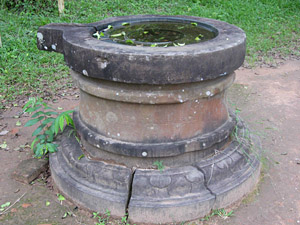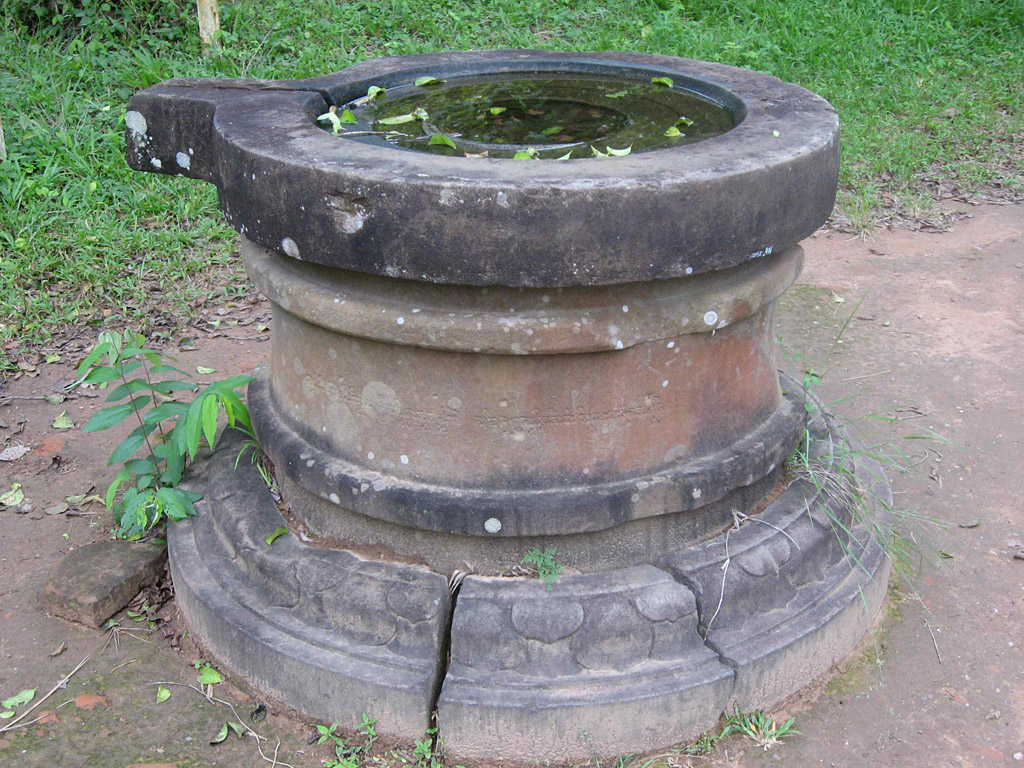Corpus of the Inscriptions of Campā




C. 97 Pedestal at Mỹ Sơn
Please note: you are reviewing a preprint version of this publication. Contents here may change significantly in future versions. Scholars with specific interests are urged to consult all cited bibliography before using our texts and translations or drawing other significant conclusions.
Support Round section of a multi-layered pedestal; sandstone; we have not recorded dimensions, and neither have previous scholars.
Text One line written in Sanskrit.
Date 6th century Śaka (7th CE).
Origin Site of Mỹ Sơn (Quảng Nam).
The pedestal composed of several circular sections was apparently in situ, between monuments E6 and E7 at Mỹ Sơn, before 1904, and the inscription on one of the sections was listed as number VIII in the list of inscriptions of this site (Finot 1904b: 930; see also the table in that article; and Parmentier 1909: 419). We identified the pedestal still in situ at Mỹ Sơn in 2009, as the one bearing local inventory number 03MSE846/Đ.7321 (see ECIC III: 458).
Edition(s) First published, with French translation, in Finot 1904b: 930; whence, with translation into English, in Majumdar 1927: 36; whence Golzio 2004: 29. Re-edited from the inked EFEO estampage, with new translation, in ECIC V: 424-427, whence the present edition.
Facsimiles
- Estampage: EFEO 342
- Estampage: EFEO n. 331
The following text was edited by Dominic Goodall and Arlo Griffiths.
a rāja° ◇ the estampage seems to show rājā, which would be unmetrical and very unlikely for a number of other reasons too. Rather than presuming an error, we assume that the stone has suffered slight damage here, so that the impression of an ā-vocalization after j given by the estampage is misleading. — d stheyād ◇ stheyān Finot. The form ending in -n supposed by Finot (and retained unquestioned by Majumdar) could be interpreted (as the comparative form of the adjective sthiraḥ), but would be awkward. Cf. also C. 96, st. XXX. — || ◇ (vac.) Finot.
Translations
English
This sheath (kośa) for (the liṅga of) Vāmeśvara was placed by the illustrious Vikrāntavarman, lion among kings. May it remain as long as will remain the earth!
French
We cite Finot's translation of 1904:
Par le lion des rois Vikrāntavarman a été érigé ce kośa de Vāmeśvara, inébranlable aussi longtemps que l'existence du monde.
Commentary
Secondary Bibliography
- Parmentier 1909: 419.
Notes
- Recorded under this number in the registration of Mỹ Sơn as a Unesco World Heritage Site



This inscription records the installation of a liṅga-sheath of a Śiva called Vāmeśvara. Finot and Majumdar take this name to be no more than a synonym of Śiva. But in his notes on the inscriptions of Campā, kindly put at our disposal, Alexis Sanderson has observed that it must be the name of the deity of a specific liṅga, surely that listed with Īśāneśvara, Śambhubhadreśvara and Prabhāseśvara in C. 81, face c, ll. 1-3 (see Đà Nẵng Catalog, p. 227-228).